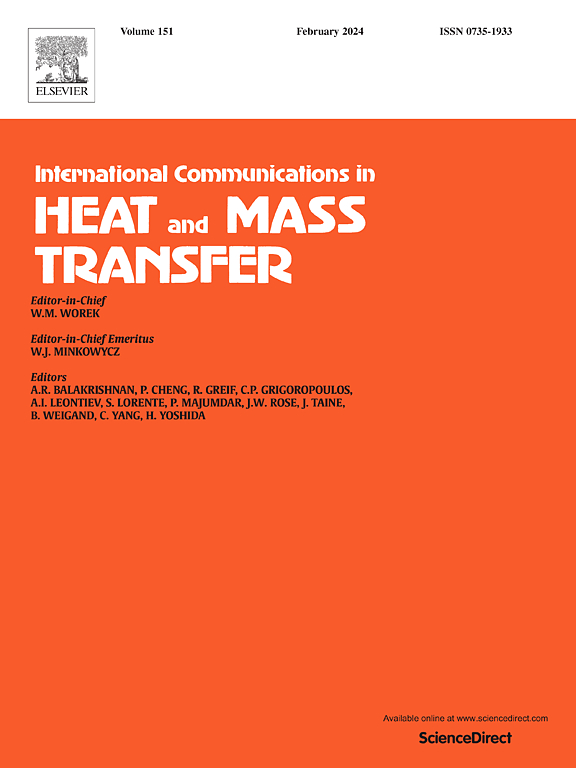A CFD based optimization procedure of operating parameters for an impinging jet on moving fabric subject to thermal dipping process
IF 6.4
2区 工程技术
Q1 MECHANICS
International Communications in Heat and Mass Transfer
Pub Date : 2025-07-22
DOI:10.1016/j.icheatmasstransfer.2025.109367
引用次数: 0
Abstract
A numerical study was conducted to investigate the flow and heat transfer characteristics in a thermal processing jet box oven, typically used in the textile and tire manufacturing industries. The internal enclosure of the jet box was optimized in four consecutive steps by varying the distance between the jet nozzles, the distance between the jet nozzle tip and the impinged fabric, the jet confinement, and also the ratio of the jet velocity to the fabric movement velocity. To quantify the influence of each parameter and to define optimum operating condition, a non-dimensional parameter, , was introduced as a measure of the thermal uniformity of the fabric compared to a reference case. It was found that increasing the distance between the jet nozzles leads to an increase in thermal uniformity of the fabric and to a decrease in the maximum normal stress imposed on the fabric. The results also demonstrated that increasing the distance between the jet nozzle tip and the impinged fabric leads to an improved thermal uniformity of the temperature distribution on the fabric and the jet confinement configuration has a significant influence on the temperature distribution of the fabric. An optimum value for the jet confinement parameter exists. The ratio of the jet velocity to the fabric movement velocity was shown to have a direct impact on the temperature distribution of the fabric and on the maximum normal stress on the fabric. With the increase in the velocity of the impinging jet, the temperature of the fabric and the normal pressure force imposed on its sides were found to increase. Overall after optimizing the operating conditions, the thermal uniformity in the fabric was improved by 84.45 %, as compared to a reference case.
基于CFD的热浸运动织物冲击射流运行参数优化方法
对纺织和轮胎制造行业常用的热加工喷射箱烘箱内的流动和传热特性进行了数值研究。通过改变喷嘴之间的距离、喷嘴尖端与被撞击织物的距离、射流约束以及射流速度与织物运动速度之比,分四个连续步骤对射流盒的内部外壳进行优化。为了量化每个参数的影响并确定最佳操作条件,引入了一个无量纲参数ηT作为织物热均匀性的度量,与参考情况进行了比较。结果表明,增大喷嘴之间的距离可以提高织物的热均匀性,减小织物的最大法向应力。结果还表明,增大喷嘴尖端与撞击织物之间的距离可以改善织物温度分布的热均匀性,射流约束构型对织物温度分布有显著影响。射流约束参数存在一个最优值。射流速度与织物运动速度之比直接影响织物的温度分布和织物的最大法向应力。随着射流速度的增加,织物的温度和施加在织物侧面的法向压力增大。总的来说,优化操作条件后,织物的热均匀性比参考情况提高了84.45%。
本文章由计算机程序翻译,如有差异,请以英文原文为准。
求助全文
约1分钟内获得全文
求助全文
来源期刊
CiteScore
11.00
自引率
10.00%
发文量
648
审稿时长
32 days
期刊介绍:
International Communications in Heat and Mass Transfer serves as a world forum for the rapid dissemination of new ideas, new measurement techniques, preliminary findings of ongoing investigations, discussions, and criticisms in the field of heat and mass transfer. Two types of manuscript will be considered for publication: communications (short reports of new work or discussions of work which has already been published) and summaries (abstracts of reports, theses or manuscripts which are too long for publication in full). Together with its companion publication, International Journal of Heat and Mass Transfer, with which it shares the same Board of Editors, this journal is read by research workers and engineers throughout the world.

 求助内容:
求助内容: 应助结果提醒方式:
应助结果提醒方式:


